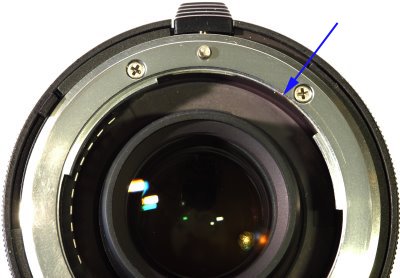Nikon TC-20E teleconverterThis is a 2x teleconverter marketed by Nikon for use with their long telephoto lenses (i.e., 300 mm and longer focal lengths) with AF-I autofocus. It also provides autofocus with AF-S lenses. Lenses with screwdriver autofocus must be focused manually with this teleconverter. A characteristic of this teleconverter is that it transmits the original focal length and aperture to the camera, without compensating for the doubling of focal length and 2-stop increase in effective aperture introduced by the teleconverter. Thus, a 300 mm lens set at f/4 still is reported as 300 mm f/4 to the camera (and in the EXIF tags of the picture) when the TC20E is used. The front bayonet of the TC-20E is not a standard Nikon mount. One of the three usual lugs is shorter, and there is an additional, short fourth lug not present in normal mounts. This prevents normal Nikon lenses from being attached to this teleconverter. Only Nikkor telephoto lenses with focal lengths equal to or greater than 300 mm (plus possibly some of the longer Nikkor zooms) can be used. The front element of the TC-20E projects slightly out of the front mount. For this reason, only lenses with a well-recessed back element can be mounted on this teleconverter (even after the teleconverter is modified as described below). In fact, if the back element of the lens is not sufficiently recessed, it will touch the front element of the teleconverter long before the two bayonets can engage, with a real risk of damaging both optical surfaces. Therefore, be extra careful when attaching a lens to this teleconverter for the first time. Because of the projecting front element, the TC-20E comes with a non-standard front cap (type BF-3). Don't lose it, because the standard Nikon cap for camera bodies (type BF-1A) cannot be used on this teleconverter. Modifying the TC-20E
The small extra lug on the front mount of the TC-20E can be removed by performing the following operations. I do not have pictures of the procedure, or of the unmodified teleconverter. The blue arrow in the above figure shows the original position of the extra lug. This procedure has been described in detail and illustrated on other web sites. Below I provide only a summary. By all means, make a web search for more detailed description if you feel uncertain about any aspect of this procedure.
In my experience, the TC-20E teleconverter, even after modification of the front bayonet as described above, still cannot be mounted on many lenses. I don't know to what extent this is true also of other Nikon teleconverters. I am not aware of the following problem - and solution - being described by other users. I found that even lenses with a recessed back element often cannot be mounted onto a TC-20E, because the front element of the latter is surrounded by a rubber sleeve. The purpose of this sleeve is preventing metal-to metal or glass-to-metal contact when attaching or detaching a lens. The sleeve increases both the length and the diameter of the barrel containing the front element. It is the increase in diameter that prevents many lenses to be mounted on this teleconverter. Removing the rubber sleeve is possible, but it will void the warranty of the teleconverter (albeit, if you have already removed the extra lug on the front mount, your warranty is already void), and will increase the risk of damaging the teleconverter and lens whenever a lens is attached and detached. With reasonable care, this should not be a problem, but a real risk exists when doing this in a hurry or in cramped settings. Therefore, perform this modification at your own risk, and only if you cannot use the teleconverter with its rubber sleeve in place.    
Using strong tweezers or small pliers, insert the tip between the rubber sleeve and the metal barrel. Push the tip down gently to get a grip on the whole length of the sleeve. Carefully pull out the sleeve. It may come out at once, or you may have to perform this operation gradually, inserting the tweezers at different points around the barrel. If everything works as expected, the rubber sleeve should come out undamaged, and can be put back at a later time if desired. Otherwise, it may break in the process. If this happens and you wish to protect the metal barrel, you can cover it with one or two turns of black plastic tape (but do not leave the adhesive surface of the tape projecting above the rim of the barrel like the original rubber sleeve does). |